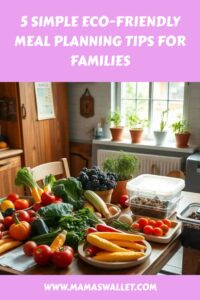
Have you ever thought about how your meals affect the planet? As a mom and blogger, I’ve asked myself this too. Let’s look at some surprising facts about our food choices and how we can make a difference.
Did you know that about one-third of all food meant for people gets lost or wasted? That’s a huge amount! And here’s something else – the average meal in the U.S. travels 1,500 to 2,500 miles from farm to table. That’s a big carbon footprint! But don’t worry, I have some easy tips to help you cut down on waste and be more green.
Key Takeaways
- Meal planning cuts down on food waste and saves money
- Planning ahead stops you from buying too much and helps avoid spoilage
- Buying in bulk and picking seasonal produce is good for the planet
- Getting creative with leftovers and storing food right makes them last longer
- Composting food scraps makes rich soil and reduces waste
Why Eco-Friendly Meal Planning Matters
I used to think meal planning was just about saving time and money. But learning about the planet’s impact changed me! Let’s explore why eco-friendly meal planning is key for our families and the planet.
Reducing Food Waste
Did you know 40% of food in the US is wasted? That’s like leaving a whole bag of groceries at the store each week! By planning meals and using low-waste methods, we can help a lot. I now use every part of my veggies and get creative with leftovers. It’s amazing how much less we throw away now!
Saving Money and Resources
Eco-friendly meal planning is good for the planet and our wallets! Shopping smart and buying local, seasonal produce saves money and supports our community. Plus, reducing food waste means we’re not wasting our hard-earned cash. It’s a win-win!
Environmental Impact of Food Choices
Our food choices greatly affect the environment. Did you know animal agriculture is nearly 60% of global greenhouse gas emissions? By adding more plant-based meals, we can cut our carbon footprint. I’ve started “Meatless Mondays” and my kids love trying new veggie dishes!
| Food Item | Environmental Impact |
|---|---|
| Beef | 18,000 gallons of water per 1 pound |
| Lentils | Lowest carbon footprint per pound |
| Local Produce | Reduced carbon emissions from transportation |
By choosing eco-friendly meal planning, we’re not just feeding our families. We’re also caring for the planet. Let’s make every bite count!
Plan Your Meals Ahead of Time
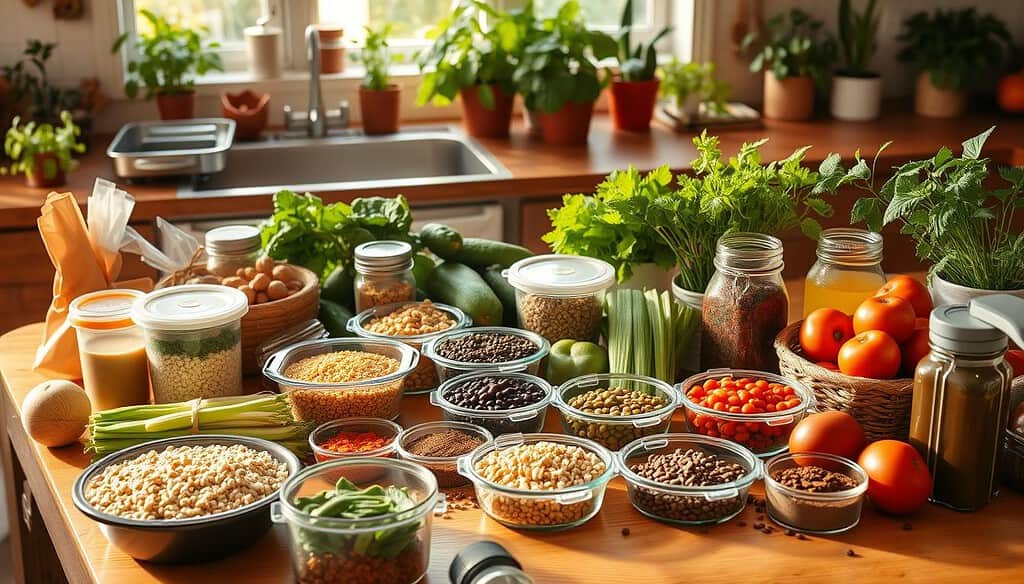
Planning meals ahead is a big help for eco-friendly meal prep. It saves money, cuts down on waste, and helps us eat healthier. Here are some great ideas that have helped us a lot!
Every weekend, I spend a few hours planning our meals for the week. I ask my kids for their ideas. This makes them excited to eat what we have and teaches them about food.
To stay organized, I use a weekly planner. You can pick a paper calendar or digital tools like Google Sheets. Here’s a meal plan I often use:
| Day | Breakfast | Lunch | Dinner |
|---|---|---|---|
| Monday | Oatmeal with fruit | Veggie wraps | Lentil soup |
| Tuesday | Smoothie bowls | Leftover soup | Stir-fry vegetables |
| Wednesday | Whole grain toast with avocado | Quinoa salad | Baked fish with roasted veggies |
| Thursday | Yogurt parfait | Veggie pasta | Bean burritos |
| Friday | Breakfast burrito | Leftovers day | Homemade pizza night |
Planning meals has reduced our waste by 30% and saved us money. It’s great to have easy meals ready for busy nights. Try it and see how it makes your meals better for the planet!
Shop Smart and Buy Local
Shopping smart at the grocery store is key to making sustainable food choices. Buying local helps you save money and protect the planet. It’s a win-win for your family and the Earth.
Create a Detailed Grocery List
Before you go shopping, make a detailed list. This keeps you on track and stops impulse buys. The USDA’s Food and Nutrition Service has helpful tips for smart shopping.
Choose Seasonal Produce
Seasonal fruits and veggies are cheaper and taste better. They add variety to your meals all year. Local farmers’ markets are great for finding what’s in season.
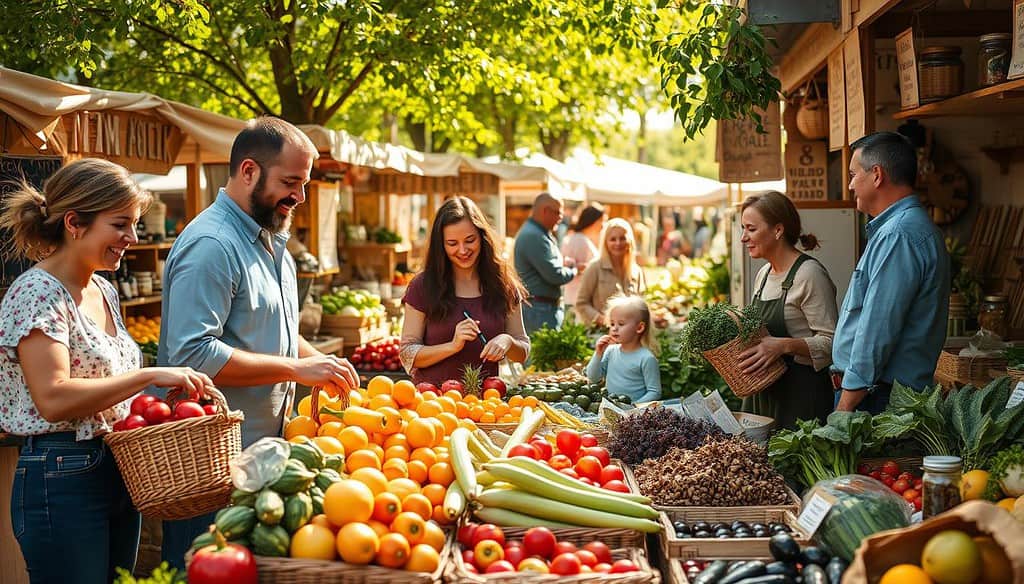
Support Local Farmers and Markets
Buying from local farmers is a big part of my routine. The produce is fresher and tastes better. It’s also better for you and helps our community.
Smart shopping is more than saving money. It’s about helping our families and the planet. By planning, choosing seasonal items, and supporting locals, we make a big difference.
Embrace Plant-Based Alternatives
I love cooking meals that are good for our planet. Livestock causes 15% of global greenhouse emissions. It also uses 70% of agricultural land. So, I try to use more plant-based foods in our meals.
Protein is important, but so is fiber. Most Americans get enough protein but not enough fiber. Plant-based foods can help with that. They also help the planet by reducing animal agriculture’s impact.
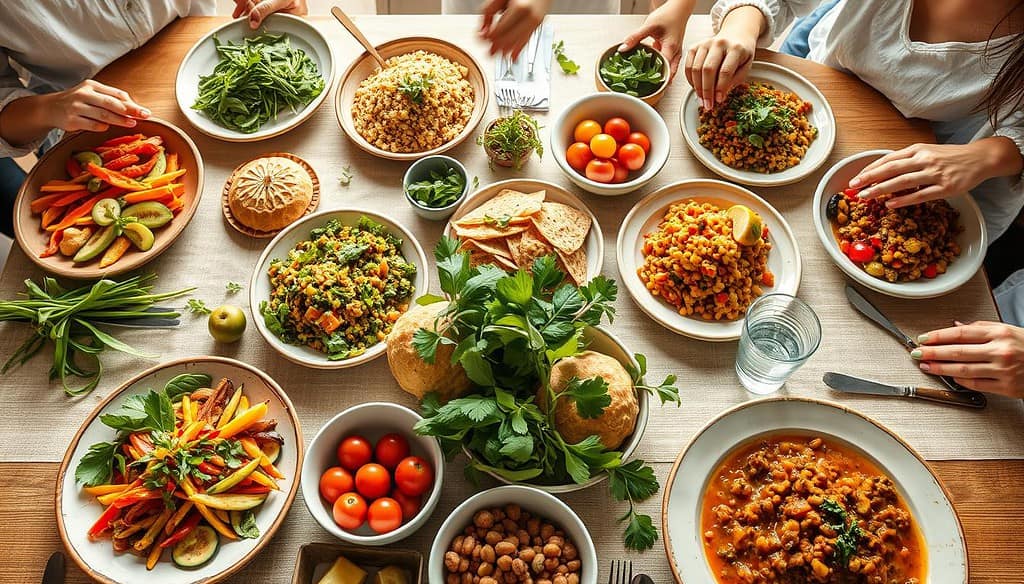
Changing to more plant-based meals is easier if you do it slowly. Start by replacing meat in a few dinners a week. Use beans, lentils, or tofu instead. These foods are good for the planet and full of nutrients.
Make sure your meals are colorful and varied. This way, you get all the vitamins and minerals you need. Plan your meals ahead to make sure you have everything.
| Meat-Based Meal | Plant-Based Alternative | Environmental Benefit |
|---|---|---|
| Beef Burger | Bean Burger | Saves 460 gallons of water per quarter-pound patty |
| Chicken Stir-Fry | Tofu Stir-Fry | Reduces nitrous oxide emissions |
| Spaghetti and Meatballs | Spaghetti with Lentil Balls | Decreases deforestation for grazing land |
Every small change helps. By choosing plant-based foods, you’re not just feeding your family. You’re also helping our planet for the future.
Eco-Friendly Meal Planning Strategies
I’m excited to share some green meal planning tips. They’ve made a big difference in my family’s eco-friendly journey. These strategies help the planet, save money, and reduce stress in the kitchen.
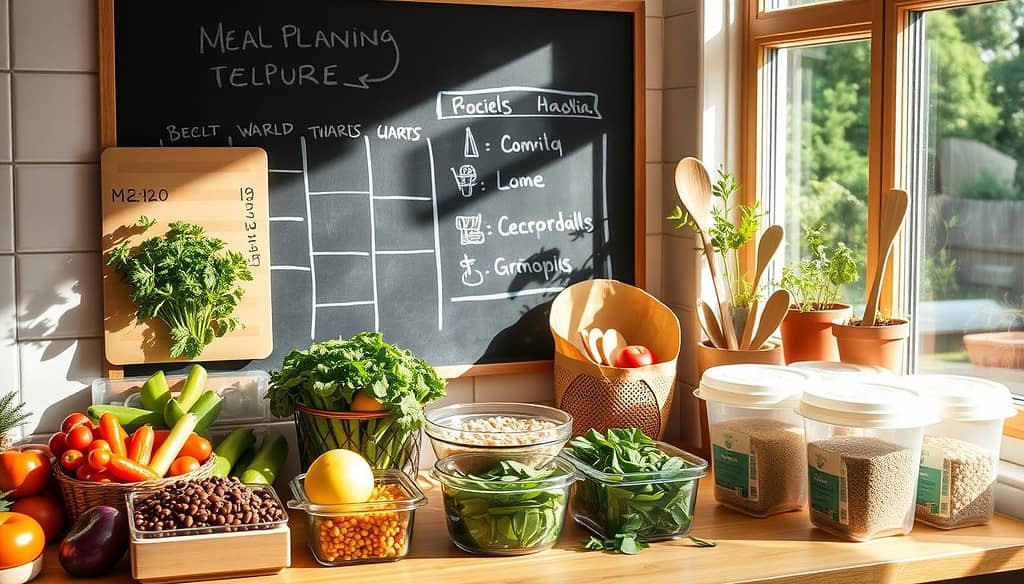
Use Reusable Containers
Goodbye single-use plastics! I’ve switched to glass and metal containers for leftovers and lunches. It’s easy to cut down on waste and keep food fresh.
Batch Cooking and Freezing
On Sundays, I cook big batches of meals and freeze them. This trick saves energy and ensures we have a home-cooked meal ready, even on busy nights.
Creative Leftover Usage
Don’t throw away leftovers! I love making yesterday’s roast chicken into today’s chicken salad or soup. It’s fun and reduces food waste.
Composting Food Scraps
Composting has changed our lives. We use vegetable peels, eggshells, and coffee grounds to feed our garden. It’s amazing how much less waste we have.
By using these green meal planning tips, you’ll see how easy it is to make your kitchen more sustainable. Remember, small changes can make a big difference in eco-friendly living!
Conclusion
I’ve learned that eco-friendly family recipes and planning meals can really help. Did you know the U.S. throws away about 120 billion pounds of food each year? That’s a lot!
By planning our meals, we can reduce waste and save money. It’s a win-win.
When I started meal prepping, our household changed a lot. We waste less food and spend less on groceries. We also eat more plant-based meals, which is good for the planet.
It’s cool to think that small kitchen changes help reduce greenhouse gas emissions. Every little bit helps.
Buying local produce, composting, or trying new vegetarian recipes all help. Let’s make sustainable meals for our kids. It’s about leaving a better world for them.